In recent years, emerging countries, particularly the BRICs—namely China, India, Brazil, and Russia—which have large populations and enjoy high growth, have been attracting attention as the new growth engines of the world economy, taking over from developed nations. It is important for Japanese companies to determine how best to benefit from the vitality of these countries. Among the BRICs, the Chinese economy is clearly the largest, and its growth rate is the most impressive. Reflecting this, Japan's economic ties with China are much closer than those with the other three countries.
The rising presence of BRICs in the global economy
The BRICs countries are increasing their presence in the world economy, aided by their rapid growth, with China playing the central role. Over the last ten years from 2000 to 2009, the share of the world GDP accounted for by the BRICs expanded from 8.0% to 15.4% on a nominal exchange rate basis (on a dollar basis), and from 16.4% to 23.5% on a purchasing power parity (PPP) basis (Table 1). This reflects the very rapid growth in China's share, on both nominal exchange rate and PPP bases. Chinese GDP reached 4.91 trillion dollars in 2009, approaching Japan (5.07 trillion dollars). The combined GDP of the other three members of the BRICs is 4.04 trillion dollars, short of China alone.
| Table 1 : Economic Size of the BRICs Countries (Comparison of 2000 and 2009) | |
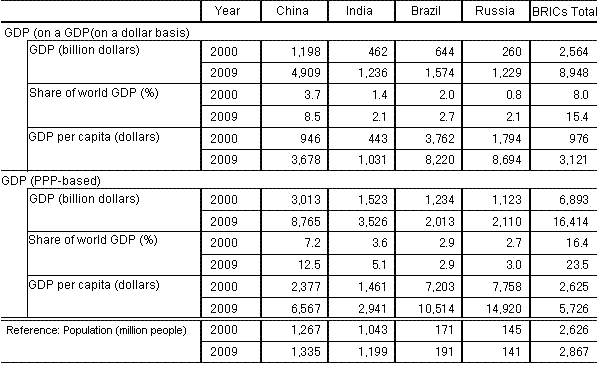 | |
| (Source) | IMF, World Economic Outlook Database, April 2010 |
The expansion of the BRICs' share of world GDP reflects the fact that the economies of these countries have been growing more rapidly than their developed counterparts (Figure 1). The growth rate of China over the last ten years (2000-2009) reached 10.0% at an annual average rate, exceeding India (6.9%), Brazil (3.3%), and Russia (5.4%). In 2009 in particular, when the global financial crisis was underway, China achieved the impressive growth of 9.1%, distinguishing itself with its strong economic performance compared to the other BRICs.
| Figure 1 : Economic Growth of BRICs Outperforms the World Average | |
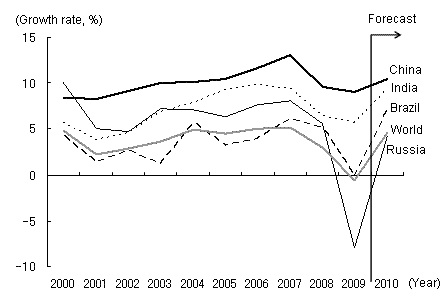 | |
| (Source) | For 2000-2007, IMF, World Economic Outlook Database, April 2010 For 2008- 2010, IMF, World Economic Outlook Update, July 2010 |
Although the economic growth of the BRICs countries has been accelerating since the beginning of this year, China continues to maintain the highest rate of expansion. IMF expects that the growth rates of BRICs in 2010 will be 10.5% for China, 9.4% for India, 7.1% for Brazil, and 4.3% for Russia. In proportion to their growth rates and shares of world GDP (PPP-based), the contribution of BRICs to the world economic growth in 2010 is expected to be 1.3% for China, 0.5% for India, 0.2% for Brazil and 0.1% for Russia, totaling 2.1%, approximately half the growth rate (4.6%) of the world economy (Figure 2). As just described, the recovery in the world economy is being driven by the BRICs, and by China in particular.
| Figure 2 : Increasing Contribution of BRICs to the World Economic Growth | |
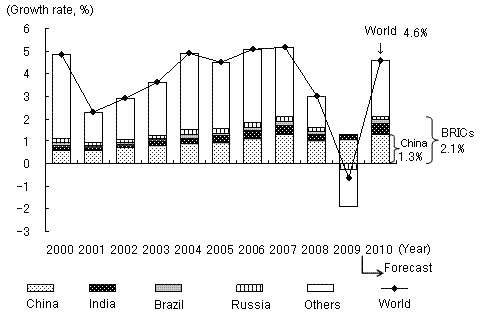 | |
| (Source) | For 2000-2007, IMF, World Economic Outlook Database, April 2010 For 2008-2010, IMF, World Economic Outlook Update, July 2010 |
The BRICs countries are enjoying rapid growth in trade, in addition to growth in GDP (Table 2). From 2000 to 2009, the share that BRICs have of world exports and imports expanded from 7.1% to 14.6% and from 5.7% to 12.5%, respectively. China has already become the world's largest exporter and its second largest importer.
| Table 2 : Comparison of BRICs' Trade | |
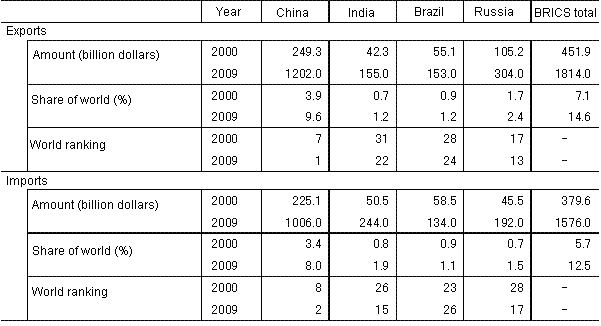 | |
| (Source) | WTO |
Contributing to Japan's economic recovery
With the astonishing growth of the BRICs as the backdrop, Japan's relations with these countries have been deepening, particularly in trade and direct investment. Again, China plays the central role.
First in terms of trade, the share of Japan's trade accounted for by the BRICs increased from 7.5% to 21.3% for exports and from 17.2% to 25.6% for imports between 2000 and 2009 (Table 3). Looking more closely at the figures, the growth of trade with China is striking, with China accounting for 18.9% of Japan's exports and 22.2% of its imports. China is already Japan's largest export destination and the largest supplier of Japanese imports. In contrast, the other three BRICs countries still have relatively small shares of Japan's exports and imports, although these shares are expanding.
At the same time, reflecting rising investment in BRICs, Japanese companies have been expanding their local production capabilities. According to the "Summary of the 39th Survey of Overseas Business Activities—Fiscal Year 2008" (compiled by the Ministry of Economy, Trade and Industry (METI), and published in April 2010), sales of local Japanese companies (including non-manufacturing) in the BRICs accounted for 16.1% of total sales of overseas affiliates of Japanese companies in fiscal 2008, with China alone representing 11.4%. Although the production of Japanese companies in the three BRICs countries other than China is also increasing, their percentages are not great at present.
| Table 3 : Expanding Trade of Japan with BRICs | |
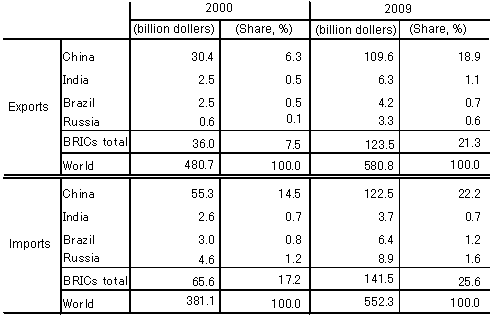 | |
| (Source) | JETRO, Japanese Trade and Investment Statistics, Japan's International Trade in Goods (Prepared from Ministry of Finance, Trade Statistics) |
The above makes it clear that much of the "emerging country effect," said to be driving the recovery of the Japanese economy, is in fact the "China effect." Nonetheless, some Japanese companies are trying to shift their foreign direct investment away from China to other emerging countries, in an attempt to diverse risk. Reflecting this, total Japanese direct investment (flow) in India, Brazil, and Russia together has been greater than the amount of direct investment in China since 2008 (Figure 3). However, with the Chinese market expected to remain the fastest growing among emerging countries, the opportunity costs associated with "China passing" are extremely high.
| Figure 3 : Changes in Japanese Direct Investment in BRICs | |
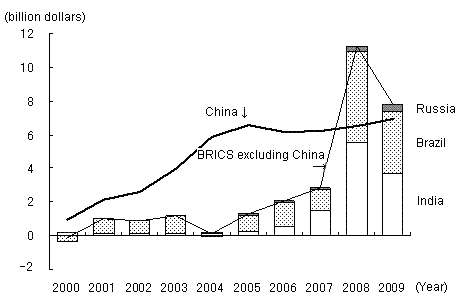 | |
| (Source) | JETRO, Japanese Trade and Investment Statistics, Japan's International Trade in Goods (Prepared from Ministry of Finance, Trade Statistics) |


